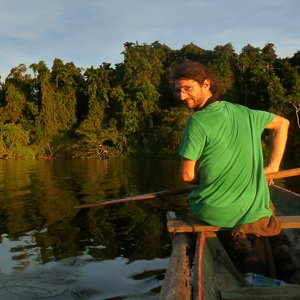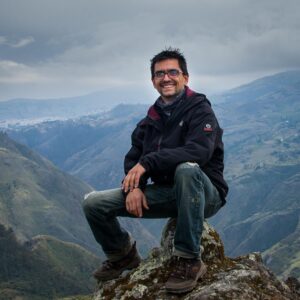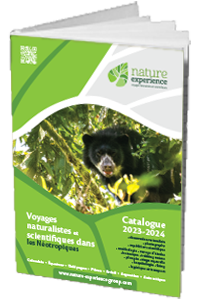Your travel expert
Dorian Noël
Naturalist and scientific travel expert

A scientific voyage to the Galapagos Islands in the footsteps of Charles Darwin, in a veritable laboratory of evolution.

Transfer from the airport to the lodge. Our guide will give us a brief introduction to the Galapagos Islands itinerary. Dinner and overnight in a charming lodge in the inter-Andean valley.
transfer from airport to hotel, welcome by our guide, overnight stay
Early departure for the airport to catch our flight to San Cristobal Island. Once there, our transport will take us to the hotel to settle in. We'll then visit the island's interpretation center, part of the "Environmental Education and Interpretation Plan for the Galapagos Islands" project. On this tour we'll learn about the history, nature and conservation projects of these islands. In the Natural History section, we'll learn about various natural phenomena, such as the volcanic origin of the islands, their isolation from the mainland, ocean currents, climate, speciation and more. We'll also analyze the islands' current situation and conservation efforts. On the way back from the interpretation center, we'll enjoy a swim in the waters of Playa Mann. After lunch, we'll head for the beach and cliff of La Lobería. La Loberia is a coral sand beach named after the impressive number of sea lions present. Our guide will explain to you about the species, their ethology, social organization in colonies or harems and the conservation state of their population. Along the cliff path, we'll be able to admire marine iguanas, as well as various species of mangroves and other coastal vegetation such as palo santo. We'll take advantage of this walk to make a botanical interpretation of the Lobería cliff, where we'll look for different species of seabirds such as Boobies, Frigatebirds, not forgetting the singular Laughing Gulls.
Dinner and overnight in a charming hotel.
hotel-airport-hotel transfer, outings and activities mentioned in the text, specialized guide, local Galápagos guide mandatory, overnight stay
Today, we'll be visiting the island's highlands. We'll discover the Junco Lagoon, a freshwater reservoir formed by a natural crater of volcanic origin and fed by rainwater. During the dry season, its level can drop by up to 1 metre, and during the rainy season, it rises and overflows. The name of this lagoon comes from the common vegetation of its surroundings, the "junco", although it is also surrounded by a species of the genus Miconia, endemic to the Galapagos. Here, we can observe the delicate flight of the Frigatebirds, and our guide will explain their biology and why they are known as "pirate birds".
During our visit to the Galápagos Reserve owned by the Jocotoco Foundation, we'll attend an awareness-raising lecture linked to the reserve's objectives such as the protection of the Galápagos Petrel and freshwater springs, where the relevance of controlling invasive species will be explained. This talk will be given by one of the park's rangers. We'll also talk about the reforestation efforts to help the ecosystem recover its native flora. Another of the region's major programs we'll be taking part in is the control of the blackberry, an invasive species that is having a very negative impact on the ecosystem. Afterwards, we'll head for the spectacular white-sand beach of Puerto Chino, where we'll observe various species of seabirds and also have time to relax.
Dinner and overnight in a charming hotel.
Outings and activities mentioned in the text, specialized guide, local Galapagos guide mandatory, overnight stay
Punta Pitt is the island's most easterly point. It consists of a series of eroded volcanic cones formed by different types of lava which, together with its distinctive xerophilous vegetation, give the landscape an unrivalled variety of colors. Punta Pitt is a nesting ground for a variety of seabirds, including the 3 species of Booby; Blue-footed Booby, Red-footed Booby and Masked Booby, as well as two species of Frigatebird. Our guide will explain the nesting survey protocol and population status of these marine species. Afterwards, we'll enjoy a snorkeling session to witness the area's marine fauna, including flag fish, parrot fish, barber surgeon fish, purple surgeon fish, various species of snapper and damselfish, among other species. After this marine spectacle of colors and shapes, it's the perfect time to talk about the dynamics of this fragile marine ecosystem.
Dinner and overnight in a charming hotel.
Outings and activities mentioned in the text, specialized guide, local Galapagos guide mandatory, overnight stay
Most of San Cristobal's inhabitants devote their professional activities to fishing and tourism. Today, we'll visit the fishing port where fishermen gather to understand the importance of natural resources for the islanders. This will be the ideal time to learn about the species and the regulations governing their capture. Next, we'll visit Tijeretas hill, where we'll be able to observe a spectacular panoramic landscape. This place owes its name to the number of Frigatebirds present. It is also interesting for historical reasons, as it was the first place Charles Darwin landed in the Galapagos. During our visit, our guide will tell us more about this scientist's important discoveries on the islands and, of course, about the theory of evolution. The flora of this area is very diverse, and we'll be able to observe native species of cactus and various mangroves. A small cove just below one of the viewpoints is the ideal spot for snorkeling and observing the marine species that lurk beneath the waters: sea turtles, sea lions, many different species of fish and, with a bit of luck, a visit from a shark. On the way back, we can enjoy a swim in the waters of Playa Punta Carola, where a large number of sea lions rest and we can also observe marine iguanas, among other species.
Dinner and overnight in a charming hotel.
Outings and activities mentioned in the text, specialized guide, local Galapagos guide mandatory, overnight stay
Early departure for a 2.5-hour sea crossing to the south. Española is the southernmost island of the archipelago and also one of the oldest. Its geographical isolation has led to the emergence of several endemic species. Look out for the Española Cuckoo or the local species of giant tortoise. The latter is a real miracle, as the population has grown from 14 survivors in 1960 to over 2,000 individuals today. But the star of the show is undoubtedly the Galápagos Albatross. From April to December, couples raise their chicks here. The courtship ritual of these winged giants is particularly rhythmic, with the clacking of their beaks and the bobbing of their heads. In the afternoon, we'll head off to a snorkeling site for a dive with schools of Galapagos damselfish, humphead parrotfish and surgeonfish. An aquatic dive with varying degrees of richness, depending on the weather and sea currents. Return to San Cristobal mid-afternoon.
Dinner and overnight in a charming hotel.
Outings and activities mentioned in the text, specialized guide, local Galapagos guide mandatory, overnight stay
The islet Leon Dormido or Kicker Rock is the remnant of an ancient cone formed by the erosion of volcanic tuff. Today we'll visit these two impressive rocks, nearly 150m high. Between them lies a channel whose clear waters are exceptional for observing various marine species: hammerhead sharks, Galapagos sharks, turtles, several species of ray, barracudas etc. It's the ideal place for sporadic sightings of hard-to-see deep-sea species. You can also observe various seabirds nesting on the rock, such as the Red-billed Tropicbird, several species of Boobies, Frigatebirds, Brown Noddy, etc... From the islet, you can observe various species such as whales and dolphins, depending on the time of year.
Dinner and overnight in a charming hotel.
Outings and activities mentioned in the text, specialized guide, local Galapagos guide mandatory, overnight stay
Morning at leisure to do some additional sightseeing before your return flight to Quito.
Dinner and evening at leisure.
specialized guide, transfers from hotel to airport.
Departures are possible all year round. Contact us for the best periods to suit your priority study topics.
You want a personalized departure date? Contact us. Request a personalized date
Price per person depends on the size of your group. Please contact us for more information.
| 2 travelers | 4 travelers | 6 travelers | 8 travelers |
|---|---|---|---|
| 2,690 US$ | 1,990 US$ | 1,780 US$ | 1,650 US$ |
You are a group of travelers and want a special rate? Contact us. Request a personalized quote
To book your tour, please confirm your agreement in writing to your local agent.
The agency declines all responsibility for the provision of confirmed services in the event of non-compliance with the above payment terms.
Itineraries may be subject to last-minute changes due to natural disasters or changes in domestic legislation. The operator therefore reserves the right to make any changes necessary to guarantee the safety and integrity of travelers and to comply with current legislation. Hotels are subject to availability at the time of booking. In the event of unavailability, a hotel of the same category will be offered whenever possible.
Formalities: Passport valid 6 months after your return date. No visa currently required for French and Belgian nationals.
Vaccines: You are advised to be vigilant when traveling, especially during the rainy season (when infectious outbreaks can occur) in the coastal provinces and in Amazonia. Malaria is a parasitic disease transmitted by mosquito bites, requiring the use of personal protective measures such as sprays, creams, electric diffusers and mosquito nets.... Quito and the center of the country are not affected by malaria. In fact, very few areas are actually affected by these parasitic diseases. The majority of these high-risk areas are not in the zones we visit on our itineraries. However, if you decide to take a course of treatment, beware: some people react badly to it. Although no vaccinations are compulsory, we advise you to consider vaccinations against tetanus and hepatitis A and C as essential. We also recommend that you consult your GP before departure, and take out insurance to cover medical expenses and repatriation.









Travel theme |
Scientific trip to the Galapagos Islands |
|---|---|
Accompaniment |
Specialized bilingual English-speaking guide |
Arrival city |
Quito or Guayaquil |
Departure city |
Quito or Guayaquil |

